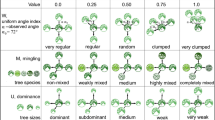Abstract
A complex plant community is analogous (though admittedly only superficially) to a human society. The members of a human community form social classes, all the members of a given class standing in a similar relationship to the members of other classes and having a similar function in the society as a whole. Each human community thus has a characteristic social structure determined by the nature and the relative importance of the classes which compose it. In a like fashion the species in the more complex plant communities form ecological classes or groups. In the community as a whole the species are of varied stature and varied life-form, but the members of the same ecological group are similar in life-form and in their relation to the environment. These ecological groups, the analogues of the human social classes, will here be called synusiae, a term originally introduced by Gams [1]. A synusia is thus a group of plants of similar life-form, filling the same niche and playing a similar role, in the community of which it forms a part. In the words of Saxton [2], who used the term in a slightly broader sense than Gams, it is an aggregation of species (or individuals) making similar demands on a similar habitat. The species of the same synusia, though often widely different taxonomically, are to a large extent ecologically equivalent.
Access this chapter
Tax calculation will be finalised at checkout
Purchases are for personal use only
Preview
Unable to display preview. Download preview PDF.
Similar content being viewed by others
References
Gams, H. (1918) ‘Prinzipienfragen der Vegetationsforschung’, Vjschr. naturf. Ges. Zürich, lxiii 293–493.
Saxton, W. T. (1924) ‘Phases of vegetation under monsoon conditions’, J. Ecol., xa 1–38.
Brown, W. H. (1919) Vegetation of Philippine Mountains (Manila).
Mildbraed, J. (1922) Wissenschaftliche Ergebnisse der zweiten deutschen Zentral-Afrika-Expedition 1910–1911 unter Führung Adolf Friedrichs, Herzog zu Mecklenburg (Leipzig).
Chevalier, A. (1917) ‘La forêt et les bois du Gabon’, Les Végétaux utiles d’Afrique tropicale française, fasc. 9 (Paris).
Booberg, G. (1932) ‘Grondvormen, étages, en phytocoenosen van Java’s vegetatie’, Hand. 6 de ned.-ind. natuurw. Congr., 1931, 329–46.
Davis, T. A. Vi., and Richards, P. W. (1933–4) ‘The vegetation of Moraballi Creek, British Guiana: an ecological study of a limited area of Tropical Rain Forest. Parts I and II’, J. Ecol. xxi 350–84; xxn 106–55.
Vaughan, R. E., and Wiehe, P. O. (1941) ‘Studies on the vegetation of Mauritius: III. The structure and development of the Upland Climax Forest’, J. Ecol., xxix 127–60.
Richards, P. W. (1936) ‘Ecological observations on the rain forest of Mount Dulit, Sarawak. Parts I and II’, J. Ecol., xxiv 1–37, 340–60.
Richards, P. W. (1939) ‘Ecological studies on the rain forest of southern Nigeria: I. The structure and floristic composition of the primary forest’, J. Ecol., xxvn 1–61.
Aubréville, A. (1933) ‘La forêt de la Côte d’Ivoire’, Bull. Corn. Aft. occid. franc., xv 205–61.
Beard, J. S. (1944) ‘Climax vegetation in tropical America’, Ecology, xxv 127–58.
Beard, J. S. (1946) ‘The natural vegetation of Trinidad’, Oxf. For. Mem., no. 20.
Editor information
Copyright information
© 1971 Palgrave Macmillan, a division of Macmillan Publishers Limited
About this chapter
Cite this chapter
Richards, P.W. (1971). The Structure of Tropical Rain Forest: Synusiae and Stratification. In: Eyre, S.R. (eds) World Vegetation Types. The Geographical Readings series. Palgrave Macmillan, London. https://doi.org/10.1007/978-1-349-15440-1_2
Download citation
DOI: https://doi.org/10.1007/978-1-349-15440-1_2
Publisher Name: Palgrave Macmillan, London
Print ISBN: 978-0-333-11031-7
Online ISBN: 978-1-349-15440-1
eBook Packages: Earth and Environmental ScienceEarth and Environmental Science (R0)




